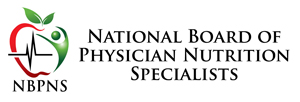Exam Overview
NBPNS Exam Detailed Content Outline
- GENERAL ASPECTS OF NUTRITION
- Nutrition through the Life Cycle
- Infancy and Childhood
- Adolescence
- Pregnancy and Lactation
- Aging
- Gender Differences
- Physiology and Pathophysiology
- Biochemical Composition of the Human Body
- Energy Metabolism
- Starvation
- The Hypermetabolic/Hypercatabolic State
- Cytokines and Eicosanoids
- Gastrointestinal Tract
- Complementary and Alternative Therapies
- Nutraceuticals
- Dietary Supplements
- Functional Foods
- Vegetarian Diets
- Elimination Diets
- Public Health
- Cultural, Ethnic, and Ethical Issues
- Technology
- Food Composition and Technology
- Genomics and Proteomics
- Nutrition through the Life Cycle
- WELLNESS PROMOTION
- Diets for Wellness Promotion
- Mediterranean
- DASH
- Vegetarian, Vegan
- Meal Replacement
- Others
- Physical Activity
- Public Health
- Cultural
- Ethnic
- Diets for Wellness Promotion
- NUTRIENTS AND INTEGRATIVE NUTRITION
- Protein
- Dietary
- Essential Amino Acids
- Nonessential Amino Acids
- Carbohydrates
- Complex
- Disaccharides
- Glucose
- Others
- Fiber
- Properties of Dietary Fiber
- Water Soluble
- Water Insoluble
- Fats and Oils
- Omega 3 Fats
- Monounsaturated Fats
- Cholesterol
- Others
- Fat Soluble Vitamins
- Vitamin A
- Vitamin D
- Vitamin E
- Vitamin K
- Water Soluble Vitamins
- Thiamin
- Folic Acid
- B12
- Vitamin C
- Others
- Electrolytes, Minerals and Water
- Sodium
- Potassium
- Calcium
- Magnesium
- Phosphorus
- Iron
- Water
- Others
- Trace Elements and Ultra-Trace Elements
- Zinc
- Copper
- Selenium
- Others
- Protein
- NUTRITIONAL STATUS ASSESSMENT
- History and Physical
- Medical History
- Diet History and Counseling
- Physical Exam and Anthropometry
- Laboratory Data
- Body Composition
- Nutrient Deficiencies and Excesses
- Energy and Protein Requirements
- Energy Expenditure
- Protein-Energy Malnutrition
- Altered Requirements in Disease States
- History and Physical
- OBESITY
- The Obesity Epidemic: Changes in the Environment
- Physical Activity
- Food Supply
- Psycho-social Environment
- Controversial Factors
- Infection Theory
- Other Environmental Agents
- Regulation of Energy Balance
- Appetite Regulation
- Adaptation to Starvation
- Energy expenditure
- Neuro-endocrine Regulation of Energy Balance
- Changes in Body Composition in Overnutrition
- Eating Disorders
- Binge-Eating Disorder
- Night Eating Syndrome
- Compulsive Overeating
- Anorexia Nervosa
- Bulimia Nervosa
- Other Eating Disorders
- Secondary Obesity
- Obesity Genetics
- Endocrine Factors
- Neurological Causes
- Pharmacologic Causes
- Pediatric Obesity
- Co-morbidities of Obesity
- Nonsurgical Interventions
- Caloric Restriction
- Physical Activity, Exercise, Fitness
- Cognitive and Behavior Therapy
- Popular Weight Control Programs
- Multidisciplinary Team Management
- Pharmacotherapy of Obesity
- Iatrogenic Complications
- Other
- Bariatric Surgery (Nonoperative Management)
- Selection and Screening
- Bariatric Procedures
- Preoperative Evaluation and Management
- Perioperative Monitoring and Management
- Long Term Monitoring and Management
- The Obesity Epidemic: Changes in the Environment
- DISEASE-SPECIFIC NUTRITION
- Gastrointestinal Disorders
- Intestinal Failure
- Pancreatitis, Acute and Chronic
- Inflammatory Bowel Disease
- Irritable Bowel Syndrome
- Disorders of Gastrointestinal Motility and Flora
- Celiac
- Short Bowel Syndrome
- Other
- Hepatobiliary Disorders
- Cholestasis
- Cholelithiasis
- Hepatic Failure
- Other
- Critical Illness
- Infection and Sepsis
- Blood Lipids and Lipoprotein Disorders
- Endocrine Conditions
- Type I Diabetes
- Type II Diabetes
- Metabolic Syndrome
- Secondary Hyperparathyroidism
- Polycystic Ovaries and other Ob/Gyn Disorders
- Other
- Renal Pathophysiology and Disorders
- Cardiovascular Disorders
- Hypertension
- Atherosclerosis
- Cardiac Cachexia
- Other
- Pulmonary Disorders and Respiratory Function
- Sleep Apnea
- Pulmonary Cachexia
- Other
- Bone Pathophysiology and Disorders
- Metabolic Bones Disease and Osteoporosis
- Osteoarthritis
- Dental
- Other
- Cancer
- Anemia and other Hematologic Diseases
- Nervous System Disorders
- Surgery and Trauma
- Genetic and Pediatric Disorders
- Transplantation
- Adverse Effects of Ethanol
- Psychiatric Disorders
- Gastrointestinal Disorders
- ENTERAL AND PARENTERAL NUTRITIONAL SUPPORT
- Relative Merits of Enteral and Parenteral Nutrition
- Indications and Contraindications
- Management of Enteral and Parenteral Nutrition
- Routes
- Nutrient Composition and Glycemic Control
- Initiation and Refeeding Syndrome
- Transitional Feedings, Weaning and Discontinuation
- Monitoring Nutritional Support
- Home Enteral and Parenteral Nutrition
- Short Bowel Syndrome
- Complications of Nutritional Support
- Mechanical
- Physiological
- Metabolic
- Septic
- Drug-Nutrient Interactions
- Pediatric Nutritional Support
